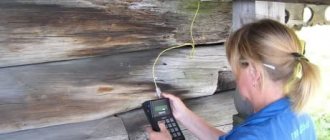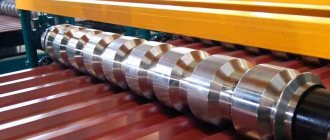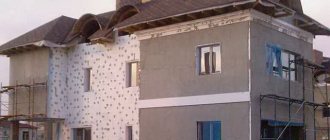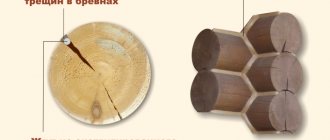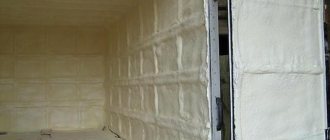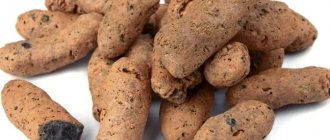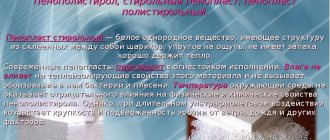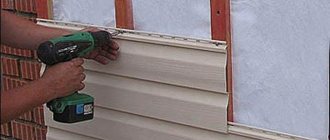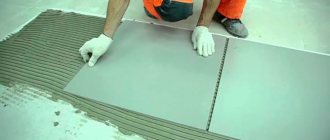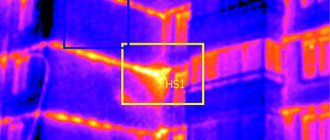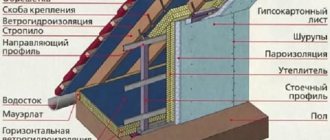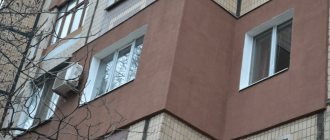Cladding requirements
In order for the future residential building to be warm and comfortable, its decoration must be treated with great care. When thinking about how to decorate the outside of a house, you should pay attention to a number of important points:
- So, when choosing a cladding, you need to take into account the cost of all the elements necessary for the work. In addition, if the facing activities will be carried out by a team of repairmen, then the cost of their services must be included in the expense item.
- It is recommended to carry out the cladding of a residential building in warm and dry weather. Thus, the finish will be fixed as firmly as possible to the base, and the structure of the material will not be damaged due to exposure to climatic precipitation.
- It is advisable to lay thermal insulation under the cladding in order to increase the energy efficiency of the building and reduce the sound permeability of the insulating layers. As a heat insulator, you can use polystyrene, penoplex or ordinary mineral wool.
- Building materials must be purchased from trusted dealers or manufacturers who have all the necessary certificates and other documents. This way, you will have the opportunity to avoid defective and counterfeit products.
- When thinking about how to sheathe the outside of a house cheaply , it is better to give preference to non-combustible products.
If you follow these rules, you can avoid additional problems in the form of downtime, damage to the coating, etc. In addition, such troubles are associated with additional time and material costs.
Siding
In some regions, planks and other lumber are not the most affordable materials. In this case, it is cheaper to cover the house with siding. This is the option when you can finish it once and forget about it for a long time.
If you are thinking about how to decorate the outside of a timber house, perhaps your option is siding
Since the sheathing is nailed onto the sheathing, the façade is ventilated. If you need to inexpensively decorate wooden walls (from timber, logs, panels), siding is one of the options. It can also be used for buildings made of any other material: foam block, aerated concrete, slag-filled concrete, etc. This cladding is universal.
Vinyl
Siding is made from polyvinyl chloride (PVC) and is therefore also called vinyl. It consists of strips of material 205 and 255 mm wide, 1.1 mm and 1.2 mm thick. The longitudinal edges have a lock on one side and perforation for fasteners on the other (self-tapping screws are more often used).
The siding is also attached to the sheathing. It is recommended to use a special metal one, but impregnated wooden blocks are quite suitable. Only standard starting and side stripes will be required. The only caveat: the screws need to be “undertightened” a little, leaving some play in order to compensate for temperature changes in the materials. With this installation, the siding will not crack due to stress.
The advantages of this material for exterior cladding of a house: low prices, easy installation.
The disadvantage of vinyl siding: it quickly fades in the sun, so it is advisable to use dim colors. It has a fairly wide operating temperature range: from +50°C to -35°C, but even in slight frosts it becomes brittle and easily damaged.
One more point: houses covered with siding and having a broken configuration look good. If the building is rectangular, without architectural frills, it does not have the most attractive appearance (as evidenced by the photo below).
If the building is simply long, without reliefs or protrusions, covering the walls with sading will not embellish it very much
Metal
Metal siding consists of strips of thin aluminum or galvanized steel, onto which a protective and decorative coating is applied. It has the same fastening system as vinyl.
Sheathing a house with metal siding is simple: you can do it yourself even without much construction experience
The coating can be made of polymers. It is distinguished by its reliability, resistance to burnout and other climatic factors. Its disadvantage is the limited choice of colors. The second coating option is powder coating. The color range is much wider, the paint lasts for years without signs of peeling.
If you are looking for something to clad the outside of your home for a durable and vibrant finish, one of the metal siding options may be right for you. It can be bent, it is very difficult to break, installation is not very difficult: you need good metal scissors, self-tapping screws, a screwdriver or a screwdriver. All installation features are the same as for vinyl, with the only difference being that metal can be installed at sub-zero temperatures.
It is not easy to harmoniously decorate a building covered with metal siding
From the point of view of durability, this is a good option, but from the point of view of aesthetics, it is difficult to work with: it looks too “manufactured”. The building no longer resembles a residential building, but rather a warehouse or some kind of workshop.
Tsokolny
This is one of the varieties of vinyl siding, but it has a completely different configuration, appearance and greater panel thickness. It was developed specifically for decorating and protecting the plinths of buildings, but I liked it so much that it began to be used for cladding facades. External design - brickwork of different types and colors, with or without drawings, wild stone. Sometimes the imitation is so successful that you can understand that it is not brick cladding, but vinyl, only by touching the wall.
In this house, the walls and gables are covered with basement siding; different collections are simply used
It is mounted, like other types, on the sheathing, there are perforations and locks. The difference is that the basement siding panel does not look like a long rectangle, but a certain section of the wall with curly edges. These curly edges are used to join. Accordingly, the sheathing must be adjusted to the size of the fragment. When installing, first the edge of the panel is inserted into the already installed lock, a match is achieved, and then secured. The main thing is that during installation, do not overtighten the screws, leaving the siding room to move with temperature changes.
The sheathing can be made of treated wooden blocks (with protective impregnation) or from plasterboard profiles (galvanized). How to install basement siding on a basement, watch the video. It is mounted on the wall in the same way. The difference is in area.
Facade plaster
This is the most profitable solution for the external cladding of a building. In addition to the fact that facade plaster serves as a decorative cladding, this composition also has some other advantages, which include the following:
- Providing thermal insulation makes it possible to provide the walls of the building with additional protection from the cold.
- The soundproofing properties of facade plasters have also caused a large number of positive reviews.
- In addition, plastering compositions increase the durability of the wall material, protecting bricks or blocks from fading, swelling, destruction and other influences.
There are many types of plaster mixtures on sale today. For exterior decoration you can use the following varieties:
- Silicone. This is the most expensive type of materials for finishing facades. But such plaster allows you to get very durable walls due to their unique composition. Among other things, silicone-based façade plaster does not absorb or allow moisture to pass through its structure. It also does not lose color or performance properties due to exposure to UV radiation.
- Mineral. This construction mixture is made from sand and cement. Mineral plaster is characterized by high resistance to temperature changes, external influences and fading. But this material is often used in industrial construction.
- Acrylic. Contains acrylic, which allows you to create a protective waterproofing film on the surface of the facade. This coating is not afraid of moisture, debris, dust and dirt. In addition, acrylic plaster will not fade under the sun. The disadvantages of the material include only low vapor permeability.
- Decorative. The good thing is that it is sold ready-made and in a single color. That is, when thinking about how to cover the outside of a wooden house, you can choose the shade of plaster for yourself and decorate the building in one tone, guided by design ideas.
It should be noted that for aerated concrete walls it is recommended to purchase plaster that is designed specifically for this material. With its help, you can eliminate defects and irregularities, as well as provide surfaces with protection from temperature changes and moisture.
Natural wood materials used for exterior cladding of a wooden house
When choosing the best way to sheathe the outside of a wooden house, natural wood materials inevitably come into view:
- lining;
- block house;
- imitation timber;
- Planken.
All of them have obvious advantages as a natural material, but they also have the same disadvantages as any wooden product. This leads to the fact that in addition to the cost of purchasing the material, it is necessary to incur certain costs for finishing with antiseptics and topcoat varnishes and paints.
Lining
The cheapest and most technologically advanced type of natural wood cladding is slats with profiled sides that form a groove/tongue connection. During installation, the lining is firmly and tightly connected and forms an almost monolithic surface.
For finishing, exclusively dry lining is used, with a humidity not exceeding 10 - 15%. If you use insufficiently dry lining, it will inevitably dry out and cracks will appear along the mating lines.
There are several standards for lining, the average dimensions of which are:
- thickness – 12 – 40 mm;
- width – 76 – 200 mm;
- spike length - 4 - 5 mm;
- length - 2 - 6 m.
The lining is installed in a horizontal position, starting from the bottom, with the tenon facing up. If you install it with the groove up, then the water flowing down the wall will get into the lock and over time destroy it and the lining itself. With proper installation and proper care, clapboard cladding will last 10 - 15 years, and if it is impregnated with modern antiseptics, even longer.
The advantage of such cladding is its low cost and ease of installation. Anyone who can hold a hammer and use a building level can handle the installation.
Imitation of timber
It is the same prefabricated surface as the lining, but slightly different in appearance. It can also be installed horizontally, only visible joints are practically invisible. After final installation it looks like a wall made of profiled timber. It is made from spruce, pine, cedar or larch; due to the resinous nature of these species, it is quite durable.
The material is produced in the form of boards 2–4 m long, 20–35 mm thick and 105–175 mm wide. You can buy a solid board, cut from one log, or spliced, glued together under pressure from narrower slats. In terms of performance, both types are approximately the same.
Pros and cons are similar to lining. Imitation timber wins only in appearance - the material is more modern and decorative.
Block house
An excellent finishing material, made in the form of boards with a semicircular outer side. When assembled, the material creates the appearance of a log structure. Very decorative, durable and no more difficult to install than lining. Compared to lining and imitation timber, a block house is more durable, holds heat better and is much more durable.
Coniferous wood species are used to make slats, in most cases pine and spruce. Impregnation with various stains, glazes and glazing materials allows you to give the finish the appearance of any valuable type of wood. When painting with oil or alkyd paints, most of the effect of using a block house disappears (in the case of imitation timber, this does not happen).
The block house also has good thermal properties. Compared to previous materials, it retains heat in the house better and lets the cold in worse. But the cost of covering with this material is higher.
Planken
This is a relatively new material in our latitudes. It is a façade board with beveled or rounded side edges. Made from pine, larch or wood-polymer materials. The width of the board is in the range of 70 – 140 mm with a thickness of 15 – 20 mm, the bevel angle of the edges is 45 – 700. It is mounted on special fastenings with a tenon or an overlap.
Very convenient for installing ventilated facades. As a rule, it is sold in a form treated with fire retardants and antiseptics, therefore it is resistant to biological pests and safe in the fire sense.
In most cases, high-quality planken is impregnated with environmentally friendly products, but when purchasing it is a good idea to check the certificate. Cheap materials can be treated with toxic reagents.
Facade paint
This is also a budget solution for cladding a house. For example, paint is perfect for finishing an old brick building that has lost its former luster, but the walls are quite durable.
Facade paint is a composition with the addition of a structuring filler. A ten-millimeter paint layer allows the walls to not only have a pleasant appearance, but also reliable protection from external factors.
A characteristic feature of this coating is that it can be used to process an unprepared base. The unique composition and structure of facade paint will mask all existing defects. In addition, this type of building composition can “breathe,” which has a beneficial effect on both wooden and block/stone walls.
Finishing with artificial materials
Reliable, durable, inexpensive, easy to install and further maintain - these are the characteristics of modern artificial materials used for the exterior cladding of a wooden house.
Exterior decoration of a wooden house involves the use of artificial materials such as vinyl or metal siding and thermal panels. To decorate a house made of timber from the outside, you can also use fiber cement boards and other materials.
Siding
Vinyl siding
Covering a wooden house with siding is a ubiquitous phenomenon in Russia. Siding has all the characteristic features of modern finishing materials mentioned above.
A significant addition to them is the huge variety of colors and patterns. In appearance, it can be a regular “lining” or the “herringbone” and “ship plank” that are quickly becoming fashionable (see photo). Imitation of wood, stone, granite, brick and many other materials looks original. Modern siding production technologies make it possible to give your home a unique look for little money.
The exterior decoration of a house made of timber can be made of plastic (vinyl) or metal (aluminum, steel) siding.
Metal siding made of galvanized steel is used quite rarely in private wooden house construction, since, having a lot of weight, it requires a reinforced foundation and a very strong frame. The unsurpassed advantage of this finishing material is its exceptional fire resistance.
Metal siding
Covering a timber house with vinyl siding is the most popular and cost-effective way to finish a wooden house.
Prefabricated strip panels, in the form of which vinyl siding is made, are lightweight and have special installation devices. This set of indicators helps speed up and simplify the finishing part of the construction of a wooden house.
When choosing vinyl siding, you need to know that color fastness is ensured by the presence of titanium dioxide in the paint, which gives the product a soft pastel shade. If the original color of the material is bright, it means that this component is missing, and it will not be bright for long.
Thermal panels
Facade thermal panels
Thermal panels with clinker tiles are a modern universal material for cladding the exterior of a log house. Its versatility lies in the fact that the polyurethane foam or polystyrene foam base of the thermal panel serves as an excellent insulation material, and the clinker tiles pressed into it are a very beautiful decorative element. The exterior finishing of a timber house with clinker thermal panels gives it a noble and at the same time original appearance.
Fiber cement boards
Fiber cement boards
A relatively new material on the Russian market for cladding the outside of a house made of timber. The board is a mixture that includes wood fiber (fiber), quartz, mica, cement and other components.
These are also fiber cement boards
The finished slab is covered with a durable protective and decorative layer on an acrylic base. Glossy or matte, imitating brick or wood, the external coating looks very presentable. In addition, it is characterized by high color fastness and ease of care.
The slabs are mounted directly on the wall without lathing, which greatly simplifies the cladding process.
Facade tiles for cladding
Facade tiles are rarely used for wall cladding - this is quite an expensive and labor-intensive task. It is good to decorate the walls in the corners with tiles - it looks beautiful and extraordinary. The tiled foundation looks great.
There are several ways to attach tiles to the walls of a house: fixing with self-tapping screws or gluing with special compounds. To carry out the work of tiling the facade, special preparation of the walls is required.
Features and benefits of siding
This type of facing material is considered very popular today. This is due to its affordable cost and excellent performance properties . Siding is long, thin panels with perforated edges for easy installation. Thanks to its design features, such cladding takes on beauty and integrity during installation.
In addition, siding panels have a very wide selection of colors. There are also various imitations on sale - marble, brick, natural stone, wood, etc. Thus, with the help of siding, you can easily give your house a unique look. There are several types of material:
- PVC panels. These are panels with a cellular structure, characterized by low weight. Due to its high density, polyvinyl chloride siding has not only good decorative, but also thermal insulation characteristics. The material is not subject to rotting and is completely resistant to moisture.
- Metal siding panels. Thin panels made of aluminum, zinc or steel. Their thickness is 4-6 millimeters. Installing them is quick and easy. Metal siding is highly resistant to corrosion and climatic influences. You can install the canvas yourself, which allows you to save on the services of a professional team.
- Wood siding. Absolutely environmentally friendly material, characterized by minimal thermal conductivity and attractive appearance. But wooden panels are afraid of exposure to moisture. And even after antiseptic and paint treatment, wood has much less durability than PVC or metal.
- Fiber cement boards. This type of siding is made on the basis of polymer fibers and a cement mixture. The result is a very durable and durable coating.
One of the main advantages of siding is that it can be installed on top of a ventilated facade, since this material will not interfere with air microcirculation .
Other methods of finishing the facade of a wooden house
There are some materials that are not so often used for cladding the walls of a wooden house, but they are still worth considering as a cladding material. First of all, this applies to materials such as corrugated sheets and facing bricks.
Facing brick
The brick facade of a wooden house is now a rarity. But it has the right to life, thanks to its exceptionally high strength, frost resistance, and decorativeness. But when installing a brick facade, it is necessary that the wooden house stand on a concrete foundation - the weight of a wall even half a brick thick is quite impressive.
Installation of a brick facade is carried out only after complete shrinkage of the wooden house, otherwise damage is inevitable. A ventilation gap of at least 5 cm between the finish and the wall is absolutely necessary. The attractiveness of a brick façade also lies in the fact that it requires absolutely no maintenance. The natural appearance is preserved for many decades.
Profiled sheet
In addition to special facade materials, the walls of a wooden house can be sheathed with ordinary corrugated sheets. The corrugated sheet is made of galvanized steel coated with a polymer protective coating. Typically this material is used for finishing technical structures. But thanks to a wide range of design solutions, today we produce corrugated sheets that imitate wood, stone or brick. Therefore, it can be used with complete success for finishing walls or individual fragments of the facade of residential buildings. The advantages of this material include: absolute resistance to negative environmental factors, no requirement for additional protection and maintenance, and non-flammability.
The main disadvantage of the material is its inability to pass steam. That is why it can only be used for cladding ventilated facades. In addition, when the material is exposed to strong mechanical loads, it can bend. At the same time, it is almost impossible to bring the material to its original smooth state.
Traditional option - wood
For facade finishing of a residential building, you can use unedged or edged boards. The last solution is lumber with smooth edges. An ugly building material is lamellas made from uncleaned and unprepared logs. As a result, sapwood, bast and bark remain at the ends of the board products. This cladding material can be used to finish wall structures with an overlap or herringbone pattern.
Such cladding, subject to proper and timely care , can last up to twenty years. After this, the boards will have to be replaced. This cladding option is perfect for a small country house, because wood has the ability to “breathe” and retain heat inside the building.
If you want to make a residential building look presentable using wood, then you can use a block house. These are the same wood panels, however, they have a convex surface, imitating a natural log. This type of finish looks very expensive and presentable. It is noteworthy that purchasing siding for a block house allows you to save several times on external cladding.
Panels for facade finishing
It is possible to finish the façade with light polyvinyl chloride panels. This material is very attractive and cheap. The cladding can imitate brick, marble, wood, natural stone and other materials. Such façade panels are distinguished by their very low weight, so their installation should not pose any problems.
Using these finishing cloths you can cladding the entire cottage. Moreover, the material can be combined by finishing the corners and base of the building with natural stone, and the wall surfaces with wood or marble.
